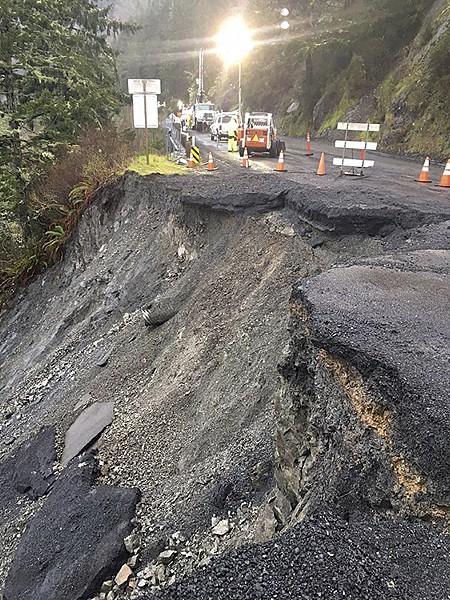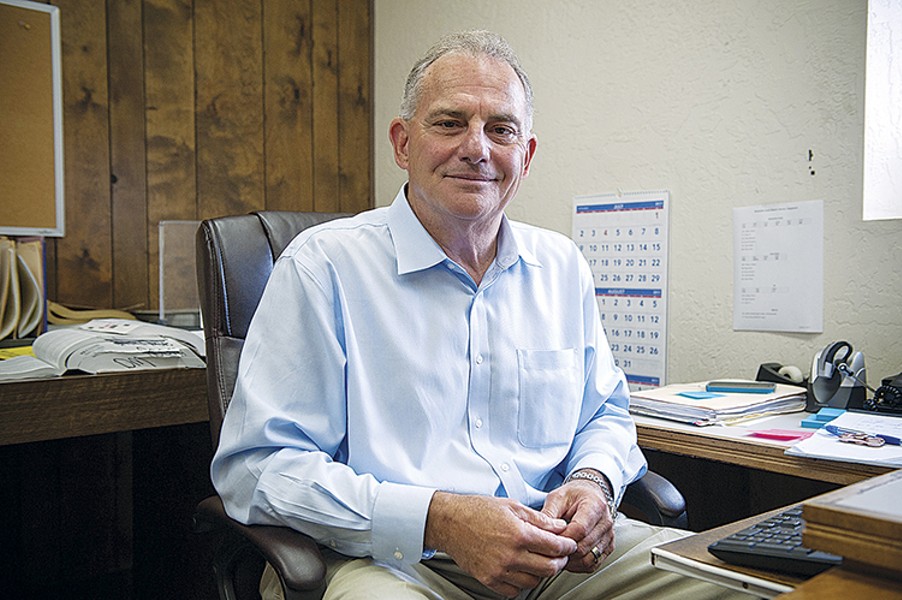What a year, Humboldt. In the pages of our 52 issues this year — and our daily online content — we've told a lot of stories, reporting on the tragedies, triumphs, laughter and tears of the North Coast. As we enter a hopefully more peaceful and prosperous 2018, we take this chance to look back on the 10 most impactful stories of 2017 with the hope that a little reflection will help make sure we build on the successes and avoid the mistakes of the past year.
Fighting addiction
The extent and consequences of our local addiction problem have been on display for a long time. This year, citizen groups like Take Back Eureka added some loud voices to the conversations around homelessness and discarded needles in public spaces, with many criticizing the harm reduction efforts of local needle exchange programs that they say have contributed to a large amount of dangerous, prickly litter. The county's overdose rates were three times higher than the state average between 2012 and 2016, according to a report from the Humboldt County Department of Health and Human Services. They remained high this year, according to the coroner's office, with 32 total as the Journal went to press.
Some potentially exciting steps were also taken to address this ongoing problem, including the transformation of the Multiple Assistance Center — which formerly offered transitional living opportunities for the homeless — into a brand new medical detox facility operating under the name Waterfront Recovery Services. As the Journal has noted before, the county previously lacked a one-stop-shop for addicts who need a medical detox from substances and Waterfront, a project of Alcohol Drug Care Services, may go a long way toward helping people get and stay clean. Another project is a yet-to-be-built opioid help center made possible by a $4.8 million federal grant announced by state Sen. Mike McGuire at an opioid town hall in early November. A timeline for the center, which will be operated by Aegis Treatment and most likely offer both counseling and medical treatment, has yet to be established.
Legalization Looms
In some ways, 2017 was a year spent in cannabis legalization limbo. It won't go down in the books as the year California voters freed the weed for recreational adult use (that was 2016). And it won't be remembered as the year that any 21 year old could suddenly walk into a pot shop and buy a bag (that'll come in January). Instead, it will be remembered as the year that Humboldt County's generations-old cannabis industry rushed to grow up amid a flurry of outside forces.
Across Humboldt County, folks hopeful to legitimize existing grows or start new ones, to launch manufacturing business or open dispensaries, worked to get permits from the county — a lengthy and expensive process for most. The county's planning department, meanwhile, struggled to keep up with the influx of applications and had only issued about 100 permits by year's end. Meanwhile, growers complained of facing the increased costs of coming into compliance — with permit fees, expensive remediation work and a litany of consultants — as a saturated market saw per-pound prices plummet.
Then, with just little more than a month left before recreational markets opened, the state dropped hundreds of pages of emergency regulations that set the rules. They included some surprises, most notably the absence of any cap on how much land a single individual or company can cultivate, leaving many Humboldt farmers fearing the welcome mat has been rolled out for the cannabis Monsantos of the world.
Changing of the Public Safety Guard
A number of local public safety agencies look decidedly different leaving 2017 after some changes at the top, beginning with the retirement of Humboldt County Sheriff Mike Downey in May. Downey, who served at the agency for 31 years, oversaw the incorporation of the county coroner into the sheriff's office during his seven years as top cop. He was succeeded by Undersheriff William Honsal, who will finish Downey's term before coming up for election next year.
Scores of people crowded the Wharfinger Building in July to bid farewell to Eureka Police Chief Andrew Mills, who cited transportation concerns as one of his reasons for taking a new position in Santa Cruz after three years working to right the ship at what had been a drama-ridden department. Capt. Steve Watson, chosen as interim chief, was officially named Mills' replacement in October. Watson has pointed to improving officer retention as a priority.
Other notable shifts included the mysterious resignation of Humboldt Bay Fire Chief Bill Gillespie in November after a closed session meeting by the Humboldt Bay Fire Joint Powers Authority. Union leaders pointed to tensions between Gillespie and line-level firefighters as a potential reason for his departure. In Rio Dell, Jeff Conner, who began his law enforcement career in that city and went on to become a county code enforcement officer, took over for Chief Graham Hill, who retired in July after 22 years with the city. Finally, county Probation Chief Bill Damiano announced he will be retiring in April after 30 years in that department. He plans to spend his time volunteering, most likely with the incarcerated.
Indian Island
A century-overdue reparations plan to the Wiyot people may see a legal challenge in 2018, if local businessman Rob Arkley gets his way.
The internet blew up in August when Arkley went on a local talk radio station to muse about the city of Eureka's ongoing negotiation to return Tuluwat to the Wiyot Tribe. Also known as Indian Island, was the site of a shameful massacre in 1860 that saw a group of Eurekans murder about 100 mostly Wiyot women and children.
A subsequent public records request from the Journal turned up a series of emails in which Arkley harangues City Manager Greg Sparks about the estimated market value of the island, which he says should be put up for a public bid ... so he can buy it. Arkley also suggests the city should put the question of whether to auction off the island on the ballot next year.
Because of nondisclosure agreements, we don't know where negotiations stand between the tribe and the city. But whether the city follows through with what's right or there's a ballot measure on the subject, it's a safe bet the story will land back on this list next year.
Long Haul for Last Chance
The first steps in the long road ahead for finding a solution to Last Chance Grade began in 2017, with survey crews putting down stakes along possible alternative routes and making assessments about what preliminary surveys are needed to help fine-tune the options.
Ever since the first wagon road was cut through the soaring cliffs just south of Crescent City, nature has pushed back, threatening to cut off the northern most reaches of California from the rest of the state with jobs, lives and the region's economy on the line.
There are, however, no easy answers. Last Chance may be a mere 3-mile stretch of U.S. Highway 101, but finding a way around comes with just about every obstacle known to road projects — from challenging geography to major environmental impacts. There's also the staggering price tag — which could top $1 billion — and finding funding, which means convincing federal officials to loosen the purse strings on emergency relief monies. Needless to say, the timeline for completion is still two-decades out.
Meanwhile, real-time monitoring continues on the landslide prone roadway that has traveled 50 feet to the west since 1937, including crews keeping a literal eye on the ground for changes in cracks and additional shifting.
"We're continuing to work on projects improving and maintaining the current alignment," Myles Cochrane, a Caltrans public information officer, tells the Journal in an email. "As long as it's open, it's safe for travel."
The David Marcus Debacle
For many of those who spend their days toiling on the second floor of the Humboldt County Courthouse, 2017 will go down as the year of David Marcus. Hired by the Humboldt County Board of Supervisors in February to fill the void left by retired Public Defender Kevin Robinson, Marcus resigned his post in November, after nine months of apparently angering just about everyone in his office, leaving clients questioning his competence and spurring a lawsuit challenging whether he was qualified to hold the job.
Marcus, who had spent the five years prior to his arrival in Humboldt County working primarily as an insurance adjuster in Florida, boasted 20 years of criminal defense experience, first as a deputy public defender in San Bernardino County then heading the Lassen Public Defender's Office. But a Journal investigative report in August didn't turn up many former colleagues ready to say nice things about the man, with most blasting his work ethic and questioning his dedication to his clients.
His tenure in Humboldt County was rocky from the start. Members of the local defense bar questioned the process — which saw an advisory panel set up to interview candidates that didn't include a defense attorney but gave seats to the district attorney, the undersheriff and the county's probation chief — before it was complete. And questions abounded about Marcus from the moment he was hired in February and people started Googling his name to find a scathing grand jury report out of Lassen County alleging Marcus only spent 30 to 40 percent of his days at work there.
In March, local attorney Patrik Griego filed a lawsuit alleging Marcus didn't meet minimum state qualifications for the position. Within a couple of months on the job, Marcus saw almost every single employee of his office sign letters sent to the board of supervisors alleging Marcus was unqualified, incompetent and failing clients.
The county stood by Marcus for months, however. But finally in November, with a key hearing in Griego's case looming and a staffing crunch in the office spurred by the exodus of some senior attorneys, the walls began to close in around Marcus. The board called an emergency closed-session meeting the afternoon before Thanksgiving and within hours Marcus had submitted his resignation, which was apparently negotiated to include $25,000 severance pay and a mutual "non-disparagement" clause.
A Question of Care
Court battles over the treatment of our region's most vulnerable residents made headlines in 2017 with the county of Humboldt in the crosshairs of two cases while skilled nursing magnate Shlomo Rechnitz faces at least three lawsuits for deaths at his local facilities.
Back in August, a federal jury found the county of Humboldt liable for $2.5 million in damages for failing to provide medical care that could have prevented the death of Daren Ethan Borges, a 42-year-old homeless schizophrenic who died in a jail sobering cell three years ago after taking a potentially lethal dose of methamphetamine.
Nancy Delaney — an attorney representing the county — has filed a motion challenging the verdict despite the judge who oversaw the civil trial warning that the evidence presented was "pretty substantial" and she would likely fail in the effort.
Still making its way through the federal courts is a $3.8 million civil rights lawsuit filed against the county this year for forcing medical treatment on Dick Magney at the end of his life, despite his legally-binding written wishes and his doctor's advice.
In determining that the county should pay his widow, Judith Magney, for attorney fees she incurred while battling to wrest back control of his care, a panel of appellate judges described the county's conduct as "profoundly disturbing."
The pending case seeks those fees along with compensatory and punitive damages.
Meanwhile, a local judge and an appellate court have denied Rechnitz's bid to move at least one of the wrongful death and elder abuses cases filed against him and his facilities, citing inadequate staff, after the billionaire claimed he couldn't receive a fair trial in Humboldt County.
Moving forward into 2018, it appears local juries will oversee the outcomes of those cases, should they make it to trial.
The Year of Trump
The swearing in of Donald J. Trump to the presidency of the United States has sent out shockwaves that have seemingly spared no corner of the nation, Humboldt County included. The businessman's stunning ascendance to the White House has energized and enraged liberal critics, fractured GOP circles, given voice to the seething frustrations of some and generally made everyone pay a hell of a lot more attention to national politics.
Locally, we saw the largest march in Eureka's history as more than 7,000 people took to the streets Jan. 21 in solidarity with women's marches held across the nation. We've also seen North Coast Congressman Jared Huffman go scorched earth on social media, trolling and criticizing Trump and his administration at every chance — and there have been plenty. Huffman, who surely has Trump to thank for attendance figures at a handful of overflowing town hall meetings in his district, also recently voted in favor of beginning impeachment proceedings against 45. Most recently, the former lawyer launched a series of "moments of truth" speeches on the House floor in which he's begun to detail his case for impeachment.
The combination of Trump's election and the Democratic National Committee's apparent efforts to stack the deck against Sen. Bernie Sanders in the 2016 primaries has also inspired the North Coast People's Alliance, which seems to be a rising force, pushing forward candidates for local offices and holding regular lunch telethon gatherings to flood electeds' phone lines for various causes.
Finally, the national monument debate — which gained a hefty head of steam after a white supremacist rally in Charlottesville, Virginia, turned violent and left a woman dead — rolled into Arcata, which saw renewed demands for the removal of the McKinley statue that has held court in the Arcata Plaza for more than a century. (This has also led to calls to remove a plaque honoring the Jacoby Storehouse that tone-deafly notes the building provided refuge in "time of Indian troubles."
No matter what you think of Trump, there's simply no arguing that he's been the most prominent figure of 2017, even 3,000 miles away in little Humboldt County.
City vs. Squires
The ongoing legal scuffle between the city of Eureka and prolific landlord Floyd Squires tumbled out of the courtroom and into the gutter in 2017.
Soon after demolishing two of his properties — including the notorious Blue Heron Lodge following a fire there — city officials sent out a press release that included a salacious, unsubstantiated, third-party allegation against Squires regarding the arson, which City Manager Greg Sparks told the Journal at the time was meant to send a message.
Also included was a full police report on the arson investigation, which the city normally fights tooth and nail to keep from the public, prompting Capt. Brian Stephens to quickly disassociate his department from the action, saying the report was released without the department's knowledge or OK.
Meanwhile, the city's now six-year-long effort to take control of more than two dozen other properties away from Squires and his wife Betty in a dispute over conditions at those buildings continues to slog its way through the legal system.
All of that is becoming even more complicated after the Squireses filed for bankruptcy protection in November, apparently in an effort to stave off an auction of those properties due to an outstanding legal award that ties back to the city's lawsuit against the couple.
Long story short, a man named Mark Adams — who briefly was appointed by a judge to oversee repairs at the Squireses' properties — was awarded $158,000 from the couple earlier this year.
When they didn't pay, Adams started foreclosure proceedings to collect the money, which the judge had basically allowed Adams to secure by using the 26 properties as collateral. For his part, Adams remains confident that the bankruptcy court will eventually allow the sale to proceed.
Regardless, judging by the attorneys lined up to represent the couple's creditors at a recent hearing on their bankruptcy, it's going to be crowded in the courtroom as the case moves forward into the next year.
#JusticeforJosiah
The slaying of Josiah Lawson, a 19-year-old Humboldt State University sophomore, at an Arcata house party in the early morning hours of April 15 shook the local community and its impacts continue to reverberate. The still-unsolved killing launched discussions about racism in Humboldt County, a litany of protests and put the university's recruitment and retention efforts under a microscope.
Police responded to a report of a fight in progress shortly after 3 a.m. and arrived to find Lawson lying in the front yard, bleeding from multiple stab wounds and Kyle Zoellner, a 23-year-old McKinleyville man, sitting slumped over in a nearby driveway, his face "mangled," according to one witness. Officers arrested Zoellner, who had been involved in a fight with Lawson and several other men at the party. Witnesses on scene fingered him as Lawson's killer.
The killing immediately took on racial overtones, as Zoellner is white and Lawson was black, and one of Lawson's friends alleged that racial bias contributed to allegedly slow and ineffective responses from police and paramedics. (A Journal breakdown of the response based on dispatch logs and interviews showed an officer arrived about a minute after the initial 911 call was made and EMTs got there about six minutes later. See "What Now?," May 4.)
After prosecutors charged Zoellner with Lawson's murder, his defense team acted boldly, insisting the court hold an evidentiary hearing to determine if there was enough evidence to support the charge within 10 days of Zoellner's arraignment, which left prosecutors scrambling to support their case. After hearing wildly inconsistent testimony from dozens of witnesses over the course of a five-day hearing, Humboldt County Superior Court Judge Dale Reinholtsen ordered Zoellner released, finding there wasn't enough evidence to hold him to stand trial.
While it appears Zoellner is still the prime suspect in the case, Arcata police have since been tight-lipped about their investigation as they compile forensic evidence and seek out additional witnesses. The lack of resolution in the case, meanwhile, has plagued Arcata, which has seen city council meetings repeatedly disrupted by protesters demanding answers and progress in the case. But it has also led to some tangible steps forward: increased dialogues on race, ongoing collaborations between campus and city leaders to make Arcata a safer and more welcoming place, and regular meals put on by volunteers that sit students and community members down together to break bread.
Editor's note: What'd we miss? Join the conversation at www.northcoastjournal.com or by sending a letter to the editor to [email protected].









Comments
Showing 1-1 of 1